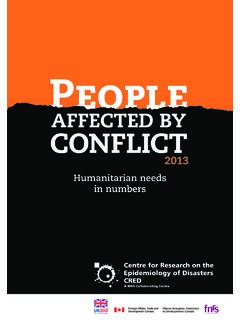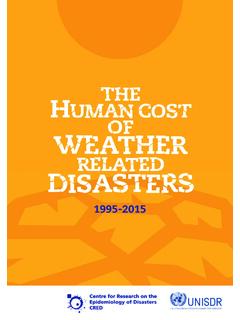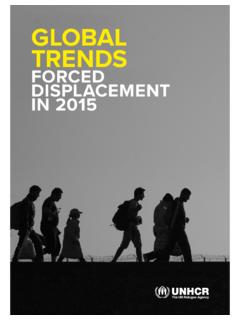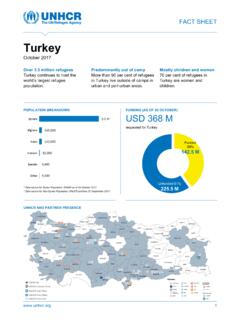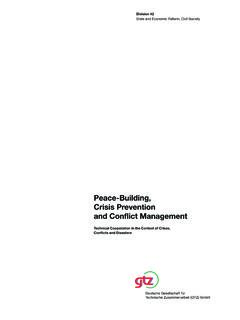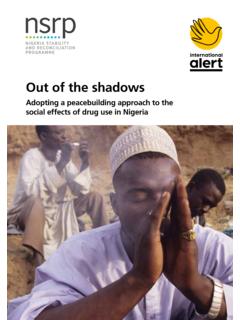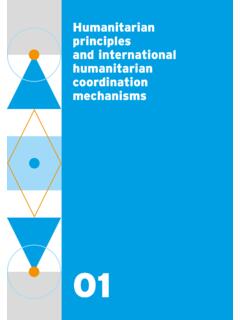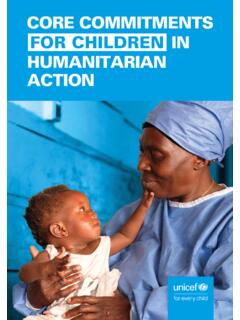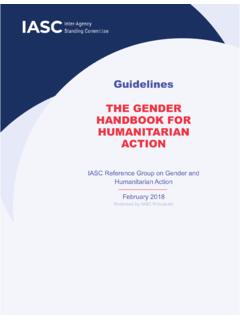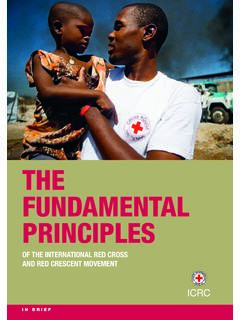Transcription of Strategy for Gender Based Violence Prevention, Mitigation ...
1 Strategy for Gender Based Violence Prevention, Mitigation and Response in the humanitarian Context GBV Sub Sector Working Group - Nigeria 2017 2 Gender Based Violence Sub Sector Strategy 2017-2018 Abbreviations and Acronyms GBV Gender Based Violence IDP Internally Displaced Persons NE North East THP Traditional Harmful Practices PSWG Protection Sector Working Group NDF Nigeria Defense Forces HNO humanitarian Needs Overview HRP humanitarian Response Plan UNFPA United Nations Population Fund GBVSWG Gender Based Violence Sub-Sector Working Group FMWASD Federal Ministry of Women Affairs and Social Development MRM Monitoring and Reporting
2 Mechanisms CRSV Conflict Related Sexual Violence MARA Monitoring Analysis and Reporting Arrangements STIs Sexually Transmitted Infections CP Child Protection 3 Gender Based Violence Sub Sector Strategy 2017-2018 Table of Contents Executive Summary .. 4 Introduction .. 4 Strategy Development Process .. 5 Situational Background .. 6 Priority Issues and Needs .. 6 Sexual Violence , Exploitation and Abuse: .. 7 Conflict Related Sexual Violence (CRSV): .. 7 Re-integration of Women and Girls formerly Associated with the Boko Haram .. 8 Domestic Violence , forced/early marriage and other forms of GBV .. 9 Access to Justice: Unfavourable Legal Environment for Litigation of GBV Cases.
3 9 Past and on going humanitarian response to GBV in the northeast .. 10 The 2017 GBV Prevention and Response Strategy .. 11 Strategic Objectives .. 12 Expected Outcomes .. 12 Geographical Coverage .. 12 Guiding Principles for all GBV Interventions: .. 13 Key 14 Annex .. 18 GBV Sub Working Group Structure .. 18 GBV Definitions and concepts .. 18 GBV Sub-sector monitoring table .. 18 Implementation Plan .. 18 4 Gender Based Violence Sub Sector Strategy 2017-2018 Executive Summary The patterns and persistence of Gender Based Violence (GBV) are inter-woven into social norms and power relations. Yet GBV is not only a fundamental violation of human rights, but leaves deep scars on societies that it affects, both in terms of psychosocial trauma, community cohesion and stigmatization of survivors, and development outcomes.
4 The threat of Gender Based Violence (GBV) amplified by the conflict in northeast Nigeria has underscored the findings by numerous scholars that throughout the world, occurrence of GBV is exacerbated when emergency hits. The humanitarian situation in the north east continues to expose communities and Internally Displaced Persons (IDPs) to major protection risks - with limited access to reproductive health and GBV prevention and response services. This Strategy describes and analyses the GBV situation in northeast Nigeria, including prevention, Mitigation and response in terms of medical, case management and psychosocial support, safety and security, mental health, access to justice and rule of law (RoL) and coordination, indicating the actual needs, challenges and response.
5 It also includes a detailed and comprehensive plan of action with activities that reflect the priorities and needs identified by the communities and GBV actors. It presents a valuable guide to critical lifesaving interventions that will ensure not only protection of women, girls, boys and men from GBV but empower them to become full functioning individuals in communities. It promotes the principle of inclusiveness and participation of affected individuals and communities to define the parameters for the framework of interventions for GBV prevention, response and Mitigation . The purpose of the development of the strategic framework is to provide guidelines and standardized approaches to GBV prevention, Mitigation and response in emergency settings to reduce vulnerability of IDPs, returning refugees and host communities of the North East (NE).
6 It will improve understanding on how to achieve improved outcomes for people living in areas affected by the crisis. The Strategy responds to the overall objectives of the Nigeria humanitarian Response Plan (HRP) and the following strategic objectives for GBV protection; 1. Increase access to a comprehensive and well-coordinated GBV response services including livelihood support for survivors. 2. Increase awareness and enhance systems for the prevention of GBV including SEA through mitigating risk factor and strengthening community protection strategies. 3. Mainstream GBV into all humanitarian response and maintain the updated comprehensive data needed to inform advocacy, planning, implementation and M&E of interventions.
7 Expected results include the enhanced capacity to better cope with the impacts of conflict and reduced exposure of women, girls, boys and men to Violence . The Strategy is also aimed at promoting accountability through strengthened coordination, community participation, access to justice, prevention and response through service provision. 5 Gender Based Violence Sub Sector Strategy 2017-2018 INTRODUCTION The vulnerability of women and girls to Gender Based Violence (GBV) especially sexual Violence in the northeast is deeply rooted in a culture where their levels of access to power and resources, as compared to men and boys is very minimal.
8 Practices such as polygamy, early/child, at times forced marriage, Traditional Harmful Practices (THP) such as widowhood practices, among others are common. Consequently, Gender Based Violence (GBV) has emerged as one of the major manifestations of the conflict between Boko Haram and the Federal Government of Nigeria, resulting into increased vulnerabilities of women and girls to abduction, rape, Violence and exploitation. The humanitarian situation in the northeast that started in 2009 has remained the biggest security threat in the country and has witnessed a series of developments in the past months.
9 The fighting between Boko Haram (BH) and the government of the Federal Republic of Nigeria has had devastating effects on the population in the northeast ranging from destruction of property, loss of lives and termination of livelihoods. Raids and bombings have destroyed vital infrastructure and civilians houses, forcing people to flee their homes and depriving them of stable, protected life and environment and access to basic services. The crisis has affected over million people in the affected states; some two million have been displaced from their homes into other states as well as to neighbouring countries.
10 About 54% of the Internally Displaced Persons (IDPs) are children and are women, with the highest number of displacements in Borno (1,446,829) followed by Adamawa (163,559) and Yobe (135,442)1. Gender - Based Violence , particularly sexual Violence , is a widespread and alarming element of the crisis. The BH, primarily targeting women and girls, uses sexual Violence as a tactic of terror. Those living in areas where the security situation is porous are at risk of rights violations, abduction, sexual slavery, rape, torture and abuse. As displacement becomes protracted, families resort to negative coping mechanisms under the strain of prolonged uncertainty and diminishing resources.
